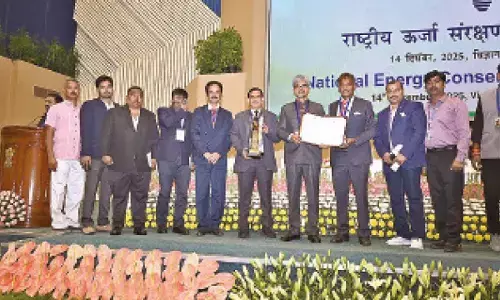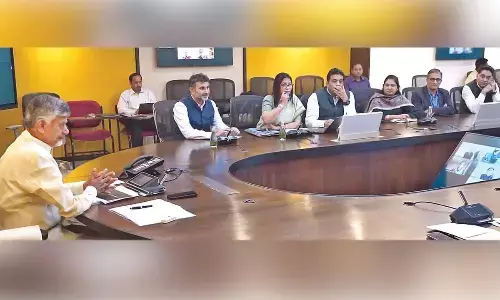Rise Of Machines: Why India need not be afraid

At a time when India is worried about the lack of adequate jobs, it is but natural that eyebrows will be raised on innovations that tend to perform humans’ tasks. This is similar to our apprehensions in the past about computers taking over workers upon mass adoption.
At a time when India is worried about the lack of adequate jobs, it is but natural that eyebrows will be raised on innovations that tend to perform humans' tasks. This is similar to our apprehensions in the past about computers taking over workers upon mass adoption.
Today, we see computers and laptops as indispensable goods in every domain. In fact, they have performed miracles — from assisting in controlling missiles to tracing water beneath dry soil.
The new set of buzz words that have entered our lexicon due to computers include workplace automation, artificial intelligence (AI), robotisation, virtual assistance and block chain.
The Google Assistant can now fairly remind your schedules, browse nearest coffee shops and plan for your health check-up on a single command.
The Aristotle, a programmable device of Mattel, can read bedtime stories to the kids and teach foreign words to the toddlers. The Steve, a security robot, can walk around a place and detect potential fires.
The nanny-robots can monitor a chicken's health. The list keeps growing by the day. By 2025, robotics is predicted to be a $67 billion sector.
Coming back to the issue of jobs, the claims about the impact of the aforesaid technologies are rather far-fetched. For starters, let us have a look at the employment share of different sectors in India.
As per the Reserve Bank of India's database, of a total 48 crore workers in the year 2015-16, 42 per cent were in agriculture, 14 per cent in construction, 12 per cent in trade, restaurants and hotels, another 12 per cent in manufacturing, 11 per cent in community, social and personal services, and the rest were in other industries.
Within the 42 per cent in agriculture, 27 per cent were farmers and 15 per cent were agricultural labourers.
But much of the new jobs generated in the past were restricted to very few industries. Between 2010-11 and 2015-16, around 1.5 crore new entrants joined the workforce throughout the country, averaging around 70 lakh new workers each year.
Business services attracted these entrants the most (23 per cent), followed by manufacturing (17 per cent), education (12 per cent), trade (11 per cent) and transport and storage (11 per cent).
Even within manufacturing, there were job losses. The textile and leather sectors lost around 12 lakh workers and the wood and furniture sector has lost around 9 lakh workers during these five years.
Much of the employment has happened in the electronic and optical equipment industries. The food and beverages sector attracted just 1 lakh new entrants a year.
It is noteworthy to mention that during these five years alone, around 2.7 crore workers have left agriculture, including farmers.
Almost equal in size, the construction sector has registered about 2.5 crore new workers, signalling the fact that much of the agricultural workers have now turned into construction workers.
This 'supply shock', along with a shift into the Mahatma Gandhi National Rural Employment Guarantee Act, has created an enormous increase in agricultural wages, the burden of which is ultimately passed on to the farmers.
The statistics from the Centre for Monitoring Indian Economy shows that between 2014 and 2018 alone, agricultural wages of men have risen by 27 per cent and for operations like picking, it stands as high as 41 per cent.
What is more interesting is that wages have risen by only 24 per cent in construction where most of the agricultural workers have shifted.
Dominated by small holders who make up 86 per cent of all farmers, a rise in cost, propelled by rising wages, could harm farm earnings.
Hence, the need of the hour is to move towards mechanised agriculture, prompted by cost-effective/affordable customs-hiring models that could compensate this labour shock and improve farmers' income.
While these models have succeeded in a few states, a full-fledged adoption is yet to be realised.
This trend of shifting into construction and other sectors would continue in the future as well. This is because non-farm jobs offer higher wages than agriculture.
The wage rate in agriculture during last December (2018) was Rs 299 a day, whereas it was Rs 332 for a construction worker, Rs 426 for a carpenter, Rs 351 for a blacksmith, Rs 472 for a mason, Rs 443 for a plumber and Rs 427 for an electrician.
With a little effort, an unskilled agricultural worker could get trained on these tasks. Moreover, they require no new skill to enter into the construction workforce.
Another reason, in our view, is that there exists huge under-employment in agriculture. Farmers and labourers are available and willing to work for additional days and months, but they can't get enough work.
Our estimates using the Labour Bureau's records showed that about 70 per cent of casual labourers in agriculture and 49 per cent of farmers are underemployed.
In absolute size, this translates to 6.4 crore farmers and 5.0 crore agricultural labourers.
When such a huge mass is placed in an environment where there are less jobs, it is natural for one to expect to migrate into high paying non-farm and urban jobs.
Employing drones and robots or applications of AI and other innovations might not altogether worsen unemployment. Much of the developed countries' applications of AI are in the finance, transportation, healthcare and defence sectors.
In India, we have not more than seven per cent of workers in these sectors.
The uses of robots are in the fields of manufacturing, construction, rescue operations and personal security. While one could think of threats to jobs in manufacturing and construction as we have high share of workers, it could still not be the case.
For example, of the 5.7 crore workers employed in manufacturing industries during the year 2015-16, only 1.1 crore belong to formal industries.
If we assume an average of 4 lakh new jobs generated in formal manufacturing each year and assume automation to the level of 10 per cent, the maximum possible job-loss turns out to be 40,000.
And not all the industries would be able to afford automation for cost reasons. If we further assume an adoption of 20 per cent industries, this further boils down to 8,000.
One could observe similar possibilities in the other sectors as well. In agriculture, one can barely expect to generate job losses as applications in pest surveillance and weather forecasting involve literally no unskilled worker.
Rather, moving towards these technologies would open avenues for new jobs, especially in information and communication technologies and data sciences. To harness potential, we require to build institutional capabilities that train the young workforce for these sectors.
There exists huge demand for skill building, not just in these emerging technologies but in the existing industries as well. Today, even in manufacturing, just 10 per cent have received some form of training.
In agriculture, construction and trade, it's just five per cent and in finance, it is six per cent. Overall, not more than six per cent workers are trained in India.
While there are definite margins for skilled personnel, the attempt to deliver skill-training could itself generate sizeable employment.
To end up, when sufficient institutional capabilities are built to train the workforce for future jobs and impart skills to the existing force, the threat to job loss could be a lesser menace.
But generating jobs for the underemployed could still be a hard matter to deal with. Bumpy roads ahead.
Balaji SJ & M Umanath (Courtesy: Down to Earth)


















